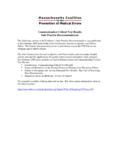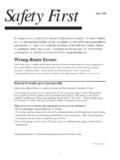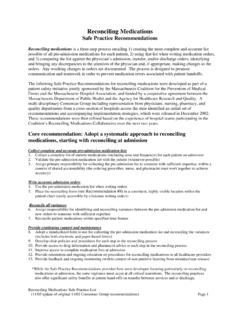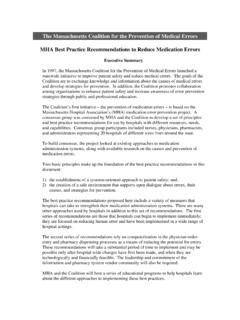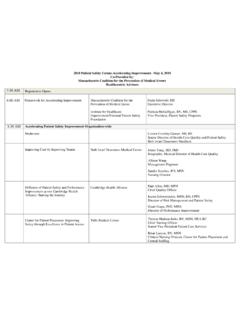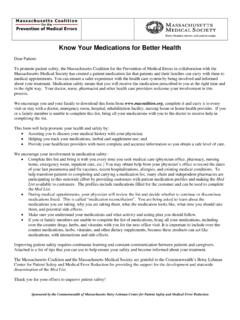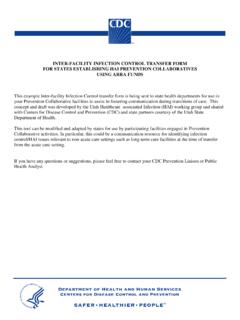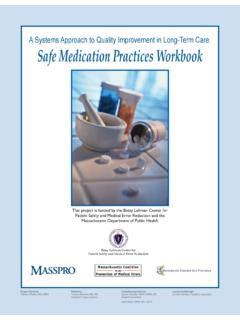Transcription of SafetyFirst - macoalition.org
1 SafetyFirst alert Massachusetts Coalition for the Prevention of Medical Errors January 2001. This issue of safety first alert is a publication of the Massachusetts Coalition for the Prevention of Medical Errors - a unique partnership of providers, clinicians, and regulators - formed in 1997 to improve patient safety and reduce medical errors. safety first alert is published periodically to alert the health care community to strategies for preventing errors known to have occurred in Massachusetts and around the country. For further information, contact Leslie Kirle, 781-272-8000, ext. 124; fax 781- 270-0605; email Errors in Transcribing and Administering Medications Twenty five percent of the errors reported to the USP Medication Error Reporting Program between July 1, 1998 and November 30, 1999 occurred during the administration phase of the medication use process.
2 It is estimated that drug administration can occupy up to 33% of a nurse's time in a hospital setting. The number of steps in the administration process will vary from one system to another, however, the basic procedures are common to all systems: transcribing, retrieving and administering the dose and monitoring. Nurses are taught the five rights as a means of minimizing opportunities for errors. The five R's are: THE RIGHT MEDICATION IN THE RIGHT DOSE, TO THE RIGHT PATIENT BY. THE RIGHT ROUTE AT THE RIGHT TIME. There are opportunities for errors even when complying with the five Rs. Identified below are potential breaks in the system and recommendations on how the opportunities for errors might be minimized. Inadequate Patient Information Lack of patient information during the various stages of the medication use process makes it difficult for health care providers to check for the appropriateness of the prescribed medication and dose and to screen for allergies.
3 Lack of this information has been identified as a contributing factor to medication errors and adverse drug events. What can you do to minimize the opportunity for error? Ensure that patient information is current and available consistently to all health care providers. Include patient information such as age, weight, height (as needed to calculate body surface area), date of birth and known allergies. 1. Know the treatment plan and the prognosis. Inadequate Drug Knowledge Adverse events have also occurred when nurses did not have enough information about the drug administered. These events were the result of not knowing the indication for the medication, not knowing brand and generic names, contra-indications, incompatibilities, cross sensitivities and/or monitoring parameters. The patient's own medications may also pose an opportunity for errors as these medications may be non-formulary or infrequently used in the institution.
4 What can you do to minimize the opportunity for error? Ensure that the drug information is current and readily available. Know the indications and appropriate dosing for the medication prescribed. If you are not sure, look it up or call the pharmacy. Know the precautions and contraindications. Know the expected outcomes after the use of the medication. Know about potential adverse reactions. Know the drug/drug and drug/food interactions. Know how to minimize the effects of an adverse reaction. Know how the drug should be administered and stored. Have pharmacy identify patient's own medications and provide drug fact sheets prior to medication administration. Lack of Protocols for High alert Drugs Lack of information and appropriate checks when dealing with high alert drugs have also been identified as a contributing factor to medication errors and adverse drug events (ADE).
5 For medications like chemotherapy, it is important to have a protocol which guides the nurse through the critical steps in the process and recommends monitoring parameters. What can you do to minimize the opportunity for error? Develop protocols through multidisciplinary committees. Ensure that all staff is aware of the protocols. Ensure that protocols are current and readily available. Review protocols periodically and update as needed. Develop protocols for high alert medications based on hospital practice. Verbal/Telephone Orders Verbal/telephone orders offer a number of opportunities for errors. Refer to safety first alert #2, Improving Prescription/Order Writing, for suggestions to prescribers on the use of telephone/verbal orders. As the recipient of these orders, you can also play a role in error proofing them.
6 What can you do to minimize the opportunity for error? 2. Minimize the use of verbal or telephone orders to emergency situations. Repeat to the prescriber/caller the order. Limit those who can accept telephone orders. Record the order directly onto the patient record at the time it is received. Have verbal/telephone orders followed up with a written order. Ensure that orders are signed and dated according to hospital policy. Verbal/telephone orders for high alert drugs should be minimized. Transcription Transcription, the transfer of information from an order sheet to nursing documentation forms, is a source of many medication errors. Contributing factors include incomplete or illegible prescriber orders; incomplete or illegible nurse handwriting; use of abbreviations; and lack of familiarity with drug names.
7 In addition to errors associated with transcribing the drug name, there is also opportunity for errors when transcribing the dose, route or frequency. Preparing a medication administration record (MAR) in an environment that is noisy or poorly lit can also contribute to errors. What can you do to minimize the opportunity for error? Clarify the order before the prescriber leaves the unit. Contact the prescriber if the order is not legible. Do not process incomplete orders. Orders must contain the following information: drug name, dose, route, dosage form and frequency of administration. Minimize the use of abbreviations and certainly avoid the use of unapproved abbreviations on the MAR. Never use the letter 'U' as an abbreviation for units. Use a leading zero before a decimal. Do not use a trailing zero after the decimal.
8 Include indications whenever possible. Check your own handwriting: is it legible? If not, think about printing using block letters. Complete the transcription process in a quiet area well lit area, away from distractions. If you are transcribing orders in a busy environment, there is the likelihood that you may make an error. Implement a system to check the medication administration record document against active orders whether the MAR is manually or computer generated. Implement a second check system for the transcription. Incorrect Dose Incorrect dose can result from the following: 1. administration of an incorrectly ordered dose;. 2. miscalculation or error in the preparation of an oral or IV dose;. 3. administration of a wrong dose sent by the pharmacy;. 4. removal of the wrong dose from a patient's medication bin.
9 5. dispensation of the wrong dose or type of drug from the automated dispensing machine; or 6. borrowing of a dose from another patient's supply. 3. What can you do to minimize the opportunity for error? Double-check the ordered dose. Check drug references for dosing information if you are not familiar with the medication. Check the dose based on route of administration. Use a unit dose system that provides medications in ready to administer form. Minimize preparation of IV medications on the unit by using manufacturer prepared solutions and having a pharmacy based IV admixture program. Read the labels on pharmacy dispensed product to determine if the ordered dose was dispensed. Check the concentration or tablet/capsule strength as listed on the package. Read the label when removing a dose from an automated dispensing machine.
10 Do not assume that it is correct because it came from a machine. Have a second nurse or a pharmacist check your calculations if you are preparing a dose on the unit and must calculate the amount of drug needed to prepare the dose, Prepare pre-calculated conversion cards to minimize calculations. If it takes more that one unit to make up a dose, check the math. One warning sign of an error may be when more than one or two vials/tablets/capsules are needed to prepare a dose. Do not crush or split enteric coated or extended release product unless directed to do so by a pharmacist. Clearly indicate the appropriate route of administration, IM, IV, SC. Read the label three times. Choosing the Correct Patient Opportunities for errors may arise when patients are transferred to different rooms or go to different areas for procedures.
